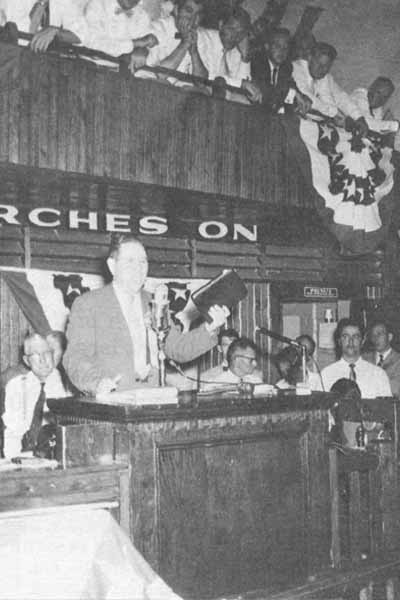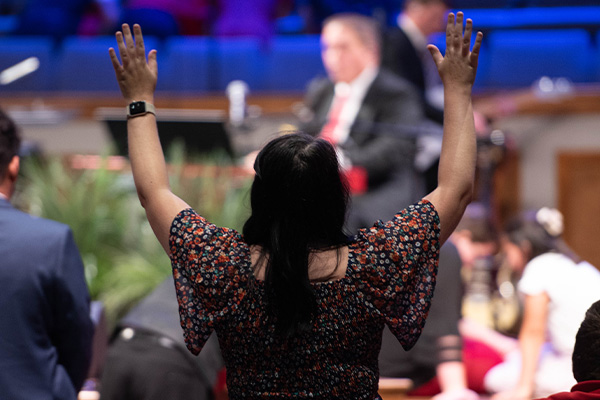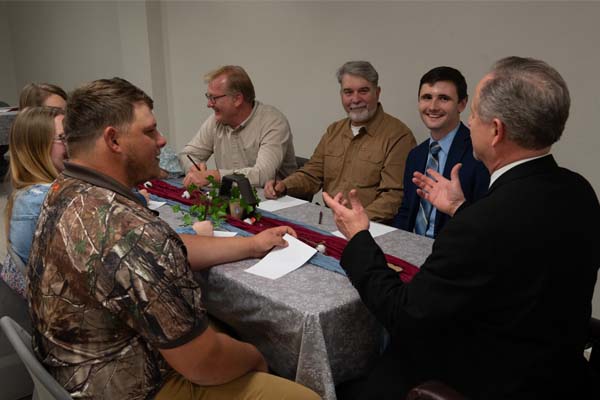There are alot of questions in this life which can lead to uncertainty. Do you long for purpose and significance in this challenging life? Do you feel as though you are all alone? Do you know Jesus as your personal Lord and Saviour? The Word of God has an answer for each of these questions, and God has a purpose for your life. The answer to all of these questions begins by recognizing our need for salvation which only comes through Jesus Christ.
The Word of God tells us that “…As by one man [Adam] sin entered into the world, and death by sin; and so death passed upon all men, for that all have sinned:” (Romans 5:12). The writer of this book also stated, “For all have sinned, and come short of the glory of God;” (Romans 3:23). When Adam sinned, man’s peaceful relationship with God was disrupted and broken, and every soul that has been born into the world since then has needed to be reconciled to God. God, in His infinite love and mercy, provided a way – His only begotten Son – that all humanity might be restored.
God’s Word reveals to us that, “For as in Adam all die, even so in Christ shall all be made alive” (1 Corinthians 15:22). Death comes to those who are guilty of sin; however, freedom from the judgment of death is available through Jesus Christ. “For this is good and acceptable in the sight of God our Saviour, Who will have all men to be saved, and to come unto the knowledge of the truth” (1 Timothy 2:3, 4). God is a merciful God who “…is not slack concerning his promise, as some men count slackness; but is longsuffering to us-ward, not willing that any should perish, but that all should come to repentance” (2 Peter 3:9).
Receiving Jesus Christ as your personal Lord and Saviour is not a difficult process and is the most important decision you will ever make in your life. “…The time is fulfilled, and the kingdom of God is at hand: repent ye, and believe the gospel” (Mark 1:15). The first step to being restored to God is to believe the Gospel which you have heard. The Gospel is God’s good news that He has given us a Saviour to save us from our sins. When we hear this good news, we must believe it and accept it as truth by faith. Perhaps you have heard the Gospel and are feeling a godly sorrow for having sinned against God. This is the Spirit of God convicting you of your sins and drawing you unto Him.
“For godly sorrow worketh repentance to salvation not to be repented of:…” (2 Corinthians 7:10). Conviction and godly sorrow will prompt you to repent of your sins and forsake your sins and sinful way of living. “The LORD is nigh unto them that are of a broken [convicted] heart; and saveth such as be of a contrite [repentant] spirit” (Psalms 34:18).
Once you have repented you can accept God’s forgiveness. His Word assures us that once we believe and repent that we are “Therefore…justified [acquitted of our sins and guilt] by faith [simply believing], we have peace with God through our Lord Jesus Christ”(Romans 5:1). We stand before God forgiven and accepted just as if we had never sinned! God promises, “For I will be merciful to their unrighteousness, and their sins and their iniquities will I remember no more” (Hebrews 8:12). Immediately upon being justified by faith, God begins His work of regeneration in the innermost parts of your heart. This is a renewing in which you pass from spiritual death unto spiritual life. You are born again into the Kingdom of God – a new creature in Christ. “Therefore if any man be in Christ, he is a new creature: old things are passed away; behold, all things are become new” (2 Corinthians 5:17).
Now that you have accepted the salvation which God provided for you through Jesus Christ, the Word of God admonishes that you should profess Christ boldly.“Whosoever therefore shall confess me before men, him will I confess also before my Father which is in heaven. But whosoever shall deny me before men, him will I also deny before my Father which is in heaven” (Matthew 10:32, 33).
If you have accepted Christ and asked for His forgiveness, you have experienced the greatest joy that anyone can have in this life. No longer are you bound by sin, and you are free to begin your new life of living for God. If you have accepted Jesus Christ as your Saviour, we encourage you to share your testimony with us! You are beginning a new life with Christ, and we would like to help you as you begin that journey with Him.
The Post-Apostolic Church
Historians of the era estimate that the Church’s membership reached into the millions very quickly with rapid growth in Gentile areas. Even while facing much persecution, the Church continued its mission unabated through the end of the third century and into the fourth.
During the early parts of the fourth century, controversy began to arise. Arius, a popular minister at Alexandria, began openly teaching against the deity of Jesus Christ. His unbiblical belief that Jesus was a creation of God rather than a part of the triune Godhead contradicted the established teaching of the Bible which insists Jesus the Son is fully and truly God.
As the dissension continued to brew, Emperor Constantine, under the power and influence of the Roman government, called for a council of bishops from the empire to convene in Nicaea. Unfortunately, what appeared to be a good step to resolve doctrinal controversy was in actuality a departure from one of the most important hallmarks of the Church – theocratic government.
Acts chapter 15 outlines God’s design for Church government, especially in the area of scriptural interpretation. First, the Holy Ghost is given preeminence: “For it seemed good to the Holy Ghost [first], and [then] to us…” (Acts 15:28). “Us”, in this passage, is “the apostles and elders, with the whole church…” (Acts 15:22).
This established procedure was interrupted when the Nicene Council made a decision to settle the Arian controversy. Not only did this gathering exclude the Church as a whole, but it also excluded bishops from outside the Roman Empire. The organization continued (and eventually became the Catholic Church) following the adoption of the Nicene Creed; however, the Church (the established order which Jesus set in order) ceased to function. Isaiah 54:7 and 2 Thessalonians 2:3 foretold this event.
The Dark Ages & Glimmers of Hope
For one thousand five hundred seventy-eight years, a period known as the Dark Ages, God’s beautiful Church was covered over by manmade creeds, false doctrine, and episcopal governments.
God was not inattentive during these years, however. Christianity underwent the Reformation Period in preparation for God to restore His Church. God chose Martin Luther, a Roman Catholic monk, to search out the conviction that pious works brought no soul satisfaction concerning salvation. As he searched the Scripture, he came to the full understanding of justification by faith. God used other sincere-hearted men to reveal His other truths – John Wesley (sanctification), Dr. Albert Simpson (divine healing), and several groups experienced the baptism of the Holy Ghost near the turn of the twentieth century.
Arise, Shine!
Inasmuch as the Dark Ages were foretold in prophecy, so was the arise and restoration of The Church of God revealed in Isaiah 60:1-5.
With the restoration of justification by faith, the cleansing of sanctification, the indwelling of the Spirit, and the practice of divine healing being widely taught, there was a renewed interest in finding the Bible church which would believe and practice these precepts amongst the field of denominationalism.
By the providence of God, a few people in eastern Tennessee and western North Carolina formed a group which became known as the “Christian Union” on August 19, 1886. This group emphasizes four vital points: freedom from man-made creeds and traditions, willingness to take the New Testament as the only rule of faith and practice, giving one another equal rights and privileges to read and interpret the Bible according to the dictates of conscience, and willingness to sit together as the Church to transact business. This group experienced minimal growth, but formed a nucleus for the fulfillment of the purpose of God.
The prophecies of Isaiah 60 were realized on June 13, 1903 in Cherokee County, North Carolina. Those who sought God’s church gathered to study the Word of God in hopes that God would reveal Her to them. In this historic meeting, one among the group, A.J. Tomlinson made the following statement after he had gone to the top of a nearby mountain for an extended session of prayer:
“I came back down the mountain and entered the meeting. Questions were asked. Bible answers were given. They said they took the whole Bible rightly divided as their only rule of faith and practice. I said, Well if you take the whole Bible rightly divided, that makes it The Church of God…Then I said, You have agreed that this that I have said makes it The Church of God, and will you be willing to take it and keep it The Church of God? They said they were willing. I then asked if they were willing to take me in with the understanding that It is The Church of God – not going to be, but is The Church of God. They were willing…Brother Spurling…took the Bible and gave it to me. He handed it to me and said, ‘Will you take this [Bible] as the word of God, believe and practice it, obey its precepts and walk in the light as God is in the light?’ Right there I gave my hand to Brother Spurling…I took the obligation with deep sincerity and extreme sacredness, never to be forgotten.” (Upon this Rock, Vol. 3, p. 64, C.T. Davidson, White Wing Publishing House and Press, Cleveland, Tennessee, 1976).
Following this momentous occasion, the Church began to grow as God began to reveal to Christians that His Church had been restored. The Church held its first Assembly since the Dark Ages in 1906, and they adopted a critical piece of God’s government: “We do not consider ourselves a legislative or executive body, but judicial [interpretive] only.”
Besides the “judicial only” declaration, the Sunday School was recommended and became the Church’s first auxiliary.
The official name “Church of God” was adopted at the second Assembly in 1907. The fourth Assembly in 1909 adopted a resolution to select a General Moderator (later becoming General Overseer) to serve full time.
The First Continuation
As the church continued to grow, there was a failure to settle several matters of doctrine and business. With each year that passed, additional contention gathered on these matters which included divorce and remarriage, church government and authority, and the system of governance and theocracy.
The governmental issues finally led to the adoption of a constitution in 1921, which, upon further evaluation, was clearly a departure from biblical theocratic principles. This resolution made the government of the Church more legislative and executive and allowed the General Overseer and counsel of elders to make decisions that should have been in the hands of the General Assembly.
Upon realizing the unfortunate departure, A.J. Tomlinson sought, in the Assembly of 1922, to eliminate the constitution and return to theocracy. Unfortunately, the damage had been done and the organization continued on the path which it had chosen.
With a remnant of those who wanted to continue with the theocratic process, on July 24, 1923, A.J. Tomlinson made a declaration of separation from the errant faction to continue on with The Church of God as originally revealed by the Holy Ghost through the Word of God.
Victory Upon Victory
The Church flourished with great progress following the continuation. In the twenty-third Assembly (1928) momentum grew as the Church adopted the “Big Business Program” that launched the Women’s Missionary Band and the Victory Leaders Band. This program also gave the Assembly Band Movement, which had originated in 1916, official recognition.
In 1933 the Church Flag was adopted and wonderfully dedicated by the Holy Ghost. Bible Training Institute was created in the thirty-fourth Assembly and the first session was held in August of 1941. Later that year, the Assembly officially adopted the Church of Prophecy Marker Association and work began on Fields of the Wood.
History reveals that the Church grew and multiplied under the leadership of A.J. Tomlinson. In October 1943, God called him home to his eternal reward.
A New Era – The Church of Prophecy
Following the death of A.J. Tomlinson, an Overseers Meeting was held, and Milton A. Tomlinson was selected to serve as General Overseer through the next Assembly. That Assembly selected M.A. Tomlinson by overwhelming acclamation to continue by divine appointment. In one sense a new era had begun for The Church of God. Yet, the transition of leadership kept the Church on the course of great growth in the ministry.
M.A. Tomlinson served the Church honorably as the General Overseer for over forty-six years. Those who knew him spoke highly of him as a man of remarkable wisdom and humility. Like his father, he put God’s will first and did his best to know and do God’s bidding.
The Church made many advancements under his leadership. Most notably were the addition of helps and services to the Church. Some of these include a strong publishing plant and department (White Wing Publishing House and Press), the Communications Department which had an extensive radio and television outreach ministry, the Visual Aid Department. The Wings of Prophecy airplane program, orphanages and children’s homes, Tomlinson College, and the Ministerial Aid and Public Relations departments. Even a new Headquarters Complex was built which included a new office building, publishing house, communication building, and Assembly tabernacle.
In 1952 the suffix “of Prophecy” was added to the Church name for business purposes to distinguish it from other organizations. The Church of God of Prophecy grew around the world and experienced its greatest period of growth under M.A. Tomlinson’s leadership with a membership totaling over 260,000 in 1990.
The Second Continuation
As M.A. Tomlinson grew older and became less able to work under the load and responsibility of the office, he, in the spring of 1990, called the State and National Overseers together to “pray and seek God’s will for the future of the Church and the office of General Overseer relative to his physical condition” (Overseers’ Meeting for the Selection of Interim General Overseer, 1990, pg. 5). The meeting’s minutes continue, “Since we have no precedent set for the leadership crisis we now face, [I’m] asking you brethren to search the Scriptures and seek the face of God in prevailing prayer before making my declaration… to your interim selection, I will then pass the mantle of this sacred office.”
While it appears that it was Brother Tomlinson’s intent to moderate the meeting through the selection of the Interim Overseer, a group of vocal Overseers pressed that it was necessary for Brother Tomlinson to tender his resignation and retirement (thus declaring the office vacant) before the selection process could begin. Reluctantly, after much discussion, Brother Tomlinson obliged their request.
The Overseers’ Meeting of 1990 concluded with the selection of a new Interim Overseer by something of a vague unanimity. Under this new leadership the Church began to be led away from its original revelation of Church government and doctrine.
Concerned members and leaders of the Church sought God’s will, and after much prayer and fasting, the Holy Ghost called for a Solemn Assembly to be held July 23-25, 1993. Those who gathered were admonished to continue fasting and praying in search for answers. On the evening of July 24, 1993, in a mighty move and demonstration of the Holy Ghost, a proclamation was made by the group to stand for the original doctrine and government prior to the changes made in the early 1990s. This group, favored by God, continued as The Church of God which Christ had originally established.
Renewed Zeal to Complete the Great Commission
During the Solemn Assembly, the Holy Ghost anointed Robert J. Pruitt to lead The Church of God, and the General Assembly of the same year unanimously confirmed his selection. Zeal to complete the work of the Great Commission was at a high, and under Brother Pruitt’s stabilizing leadership, the Church quickly grew and prospered. A new Headquarters complex was built to house the administrative and supportive offices of the Church. In the Assembly of 2001, the Holy Ghost gave the Church a new flag to display for His truth.
Like his predecessor M.A. Tomlinson, Brother Pruitt began experiencing the adverse effects of declining health in the mid 2000s, and he tendered his resignation from the office of General Overseer in 2006. During the Overseers Meeting of 2006, Stephen E. Smith was selected to serve as Interim Overseer. He continued in the role of General Overseer after unanimous selection at the following General Assembly.
The Church of God continued its success under the leadership of Brother Smith. His leadership oversaw the expansion of the Headquarters complex, an investment in using modern technology for ministry via mediums like the Internet and live streaming, and the renewal of the marking program of the Church of Prophecy Marker Association. He served the Church faithfully until 2015.
Following the death of Brother Smith, Oscar Pimentel was selected unanimously during the Overseers Meeting of 2015 and was confirmed with acclamation during the selection process at the General Assembly.
Details of the future are, of course, unknown, but the prophecy of God is clear concerning the Church. The hour is late, but the brightness of the “arise, shine” lies just ahead. Without a doubt, perfection will be obtained, for it has already been declared of the Church that Christ will “…present it unto himself a glorious church, not having spot, or wrinkle, or any such thing; but that it should be holy and without blemish” (Ephesians 5:27; see also Revelations 19:6-9).






























































































